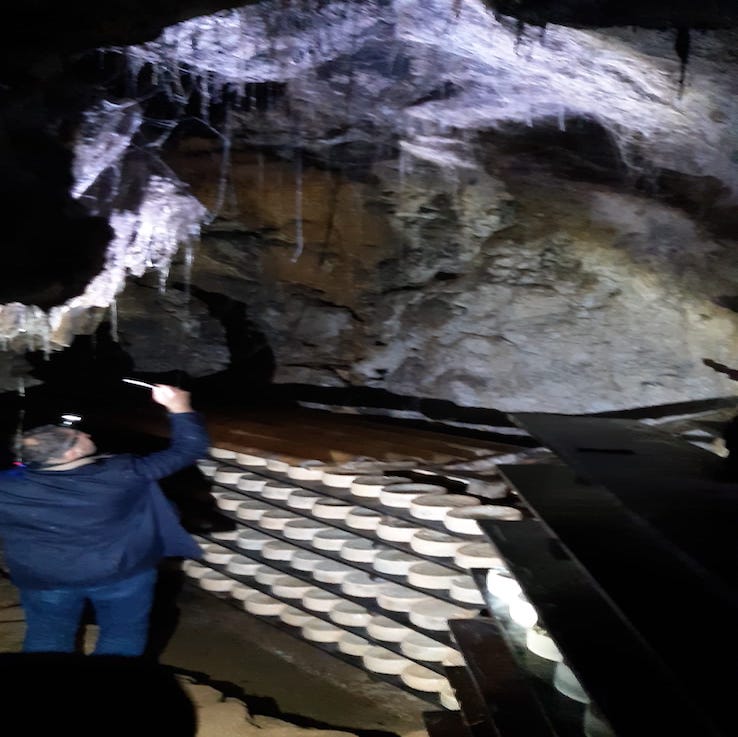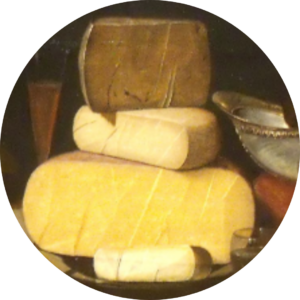
In the Spain’s Picos de Europa – The Peaks of Europe – are the hidden maturing caves for aging one of the strongest and possibly most challenging cheeses on the continent. This tradition of aging cheese in caves dates back thousands of years, but in Asturias, home of Cabrales, it takes a very blue turn.
Caves and Cheese
From the Mendips for cheddar to the Alps for Gruyere, cheeses have been matured in caves. Cheesemakers have learnt to use these natural wonders to carry cheeses over the winter and help cope with the lean times.
More wily cheesemakers took advantage and began to make cheese that didn’t just hold over – they thrived. In the right hands and the right caves new and deeper flavours develop. The consistent climate, often at an ideal 8-12oC, perfect humidity and air circulation made them better than fridges (not that they had them back then).
What they didn’t know was that each cave has a unique microbiome, a community of yeasts, moulds and bacteria that colonise the cave and so colonise the cheeses. The microbiome delivers an injection of new flavours.
Caves are magic!
Even if the medieval cheesemakers didn’t know the science, they knew something mystical was happening. It is no wonder that the French for cellar is cave. To them it’s for copying the cave’s perfection in preserving, storing and maturing.
Cabrales and Caves
So that’s for normal caves. Cabrales caves are not that kind of cave. The Picos are wet. Rain clouds sweep in from the Bay of Biscay and drop their load as they climb the mountains. Spain in general gets 300-600mm per year, often less. The Picos get a whopping 1,000-1,800mm or more. And that rain makes the caves wet, like it rains in the caves.
Too wet for typical mountain hard cheese. The caves are often long and narrow. Water drips through the cracks from the soil above. There are puddles on the floor, and sometimes duck boards guide you across permanently flooded floors.
Good for (some) Blue Cheese
The local cheesemakers are an innovative bunch. They needed to make and store cheese from their cattle, pastured on the steep sided hills.
So, they made a weird cheese, a cheese unlike any other I know. Blue cheese needs to be soft, with high moisture for growing moulds, and you need to inoculate it with blue moulds to get a uniform development inside the cheese.
The Cabrales makers don’t do that. It’s taken me a while to get my head around it, but they make dry cheese, cake shape and sized, and don’t inoculate. They hand it over to the spirits of the cave to do all that and the cheese comes alive and goes wild.
In the caves the cheese absorbs that water fresh from the soil, and with it the spores of the penicillium roqueforti that haunts every cave in the world. The result is a cheese that is more fungi that dairy. There is so much metabolic activity it takes the grey colour of a Hollywood zombie and has enough blue veining that the paste is nearly entirely consumed!
Gates, Cows, Flies and Spiders
The caves aren’t empty. In the olden days they were refuges for the people of the mountains and their cattle. They built stone huts, fortress-like, over the entrances of the caves with heavy studded wooden doors. Behind these defenses the caves are hidden passageways, often down steps and behind gates, leading deep into the mountains. Each cave has a different personality, their characters linked to how high or low in the mountains you find their entrance.
Caves are shared, with many families having their own rows of shelves. The family cheesemaker makes their pilgrimage down by the rivers and up slippery grass and stone paths. They are often only accessible by foot. They bring their new cheeses, and turn and check the cheese being transformed inside.
Now, cows and people are in barns and houses, and spiders are the new guardians keeping the flies at bay. If the cave hasn’t been visited in a week or so, the cobwebs are like veils behind which the cheeses modestly and beneficially rot.
What Does it Taste Like?
Some savoury, some salt, some acidity. No sweetness. There are low levels of milk and cream. Earthy, mushroom, rock and minerality flavours abound. These are all to the good, but what sets Cabrales apart is the hugely powerful trigeminal notes of astringency, metallic notes, aluminium, even battery acid. It sometimes reminds me of when, as a boy, I put my tongue on the terminals of those little 9 volt batteries.
Not for the Feint Hearted
If you were to ask me what is the strongest most pungent, most palate-overwhelming cheese in the world I would say Cabrales. And it all comes from these caves.
Enjoy the video.
Check out some of our other cheesy blogs here.



